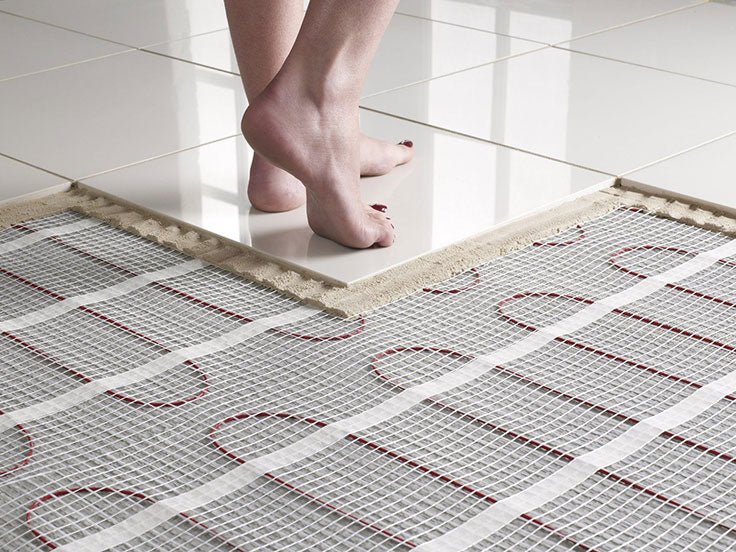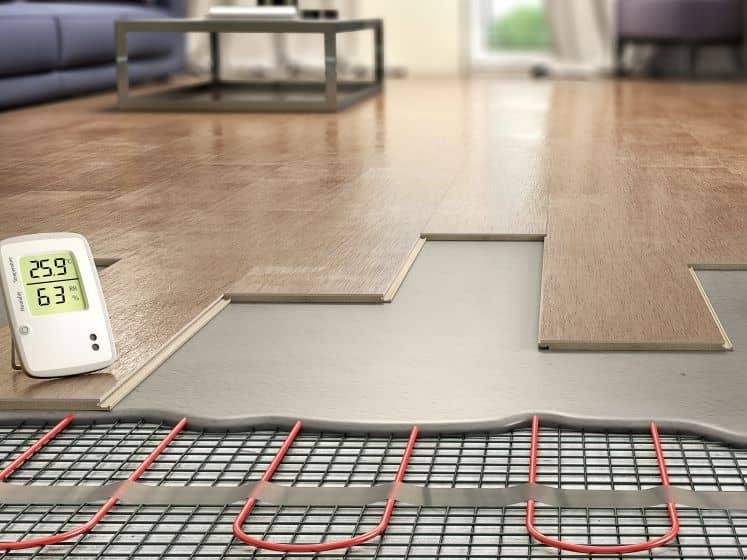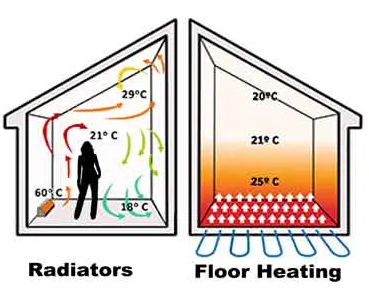Underfloor heating options
So you have finally decided that you want underfloor heating in your home or office…. good choice!
There are different types of underfloor heating which greatly depends on your application. Will it be for your home or for a business? Will you be using it under tiles, wooden floors or carpets? Will it be applied inside your home or outside on the patio? Do you prefer an electrical system, solar system or do you prefer a wet system where warm water circulate under the floor to each room? Do you want to install this in a new house or is it for renovations.
As you can see, there are so many questions and options to decide on your underfloor heating system, but we hope after reading this page, you will have a better idea of what you need and want.
Types of underfloor heating systems.
There are two different types of underfloor heating systems, an electrical system and a water system.
Electrical underfloor heating system
The electrical system heats a room with an electrical grid system installed under your floor that radiates the heat into the room. This system is usually installed during renovations and can take from a few hours to a few days. With this system, the floor profile can either stay the same or be raised slightly, depending on the floor mass (concrete and floor finish). The electrical heater can be installed under tiles, wooden floors, carpets or screed floors.
This system can be switched on and off when needed, and will be quite effective within a short period of time.
Hydronic heating system
The water system (hydronic) is a series of pipes that are installed under your floor which are connected to a manifold being fed warm water from a geyser. This water are heated up and then circulated throughout the building or specific rooms which will in turn heat up the rooms when the heat is radiated from the floor.
The hydronic underfloor heating system can be installed under most types of floors like ceramic tiles, porcelain tiles, epoxy floors, marble, granite, sandstone, slate, carpets and most wooden floors.

Heating for tile floors
Heating of tiles are attained by placing an electrical heater or a water heating system under the tiles. An electrical heater system is easier to install but the running cost is higher than a hydronic (water) system.
Under-tile heating doesn’t only heat up your tiles, but also warms your home to a comfortable level.

Heating for wooden floors
There is a common misconception that underfloor heating will damage your wooden floors and can thus not be installed, but this is not true. It is true that should it be installed incorrectly, it can lead to damage of your floor.
We do it RIGHT!

Heating for carpets
Warm your carpets so that your kids and animals can spend their winters cosy on the floor – kids spend a great deal of their lives there – and your feet will also thank you for it.
Heating your carpets is instant and can be switched on when needed. Your whole home will benefit from it, and it can be installed with most carpets.

Hydronic underfloor heating
The most effective and cost saving method of heating your home or office is by using a hydronic system.
This underfloor heating system circulates warm water to every part of your home to ensure a constant temperature through out. This system can be left on during the day and even when you are away for a weekend.
Is underfloor heating better than using heaters?
When using a heater, the air around the heater is heated quickly and effectively. We all learned in science that warm are goes up and cooler air takes the place of the warmer air. This way, a breeze is formed that creates a convection and a stream of cold air that accumulates at the floor level.
When using an underfloor heating system, the mass of the floor (screed and floor finish) is heated and the heat radiates into the room. This way, the heat stays at floor level and heats up the room evenly, eliminating any cold spots and allowing for the occupants to feel the warmth sooner.

Radiators vs Underfloor heating
As can be seen from this image, air around the heater is heated instantly which then moves up. All the warm air is concentrated at the highest point in the room where it escapes through a ventilation hole. The lower part of the room is still left cold.
Underfloor heating heats up the floor which transfers the heat by radiating it to the air. This way the warmth is close to the ground where the user can enjoy it.

Children’s playground
Children like to spend a great deal of time on the floor, whether it is for crawling, the first steps, learning, games, chatting with friends or wrestling to see who’s the strongest…. make it comfortable for them and open up their world of knowledge and fun!
Advantages of underfloor heating
Is it worth it to install an underfloor heating system? What are the benefits of it compared to a conventional radiator heater? What are the disadvantages of an underfloor heater?
Here is a list of some of the advantages of an underfloor system:
- Reduce cold spots in the room
- Running at a lower temperature, thus more cost effective
- Compatible with most carpets and floor types
- No space stealing radiators, thus up to 15% more space
- No ugly elements or radiators, more aesthetically pleasing
- Safe for children and animals, no hot elements to burn on
- No air blown around which minimizes allergies and hayfever
- It can be run off solar, gas or electrical power
- It increases the value of your home
- Safe for schools, homes, nurseries, hospitals, vet practices etc.
- It is buried in the floor, thus tamper proof
- 100% waterproof, thus safe to use in any room, even bathrooms
- Life expectancy of 50 years
- Controlled with a thermostat
And of course there are some disadvantages of underfloor heating systems:
- Underfloor heating is more expensive to install than a comparable radiator system — it typically costs 20% to 50% more
- Installing an underfloor heating system takes longer, depending whether it is an electrical or wet system
- If you are retro-fitting, the floor level have to be kept in mind. It might have to involve some digging to get the floor level correct
- Some areas are installed after placing of heavy furniture, moving it around might be more problematic
- Repairs to the system might take longer
- Life expectancy of 8-12 years
Can a home owner install it themselves?
Yes absolutely!
Installing underfloor heating is a difficult job and one that requires careful planning and a sound understanding of the necessary materials and specifications. It is unfortunately not an annual leave or weekend-off project and is best handled rather by a knowledgeable professional installer as doing it wrong will eventually end up costing you a lot more than it would have initially…. which will end up in you getting them anyway to fix the mess you made!
Some of our previous completed installations can be seen in our gallery
